Home » 10 Factors to Consider When Installing a Fire Suppression System on Work Vehicles

The installation of a fire suppression system is not just an option but a necessity when it comes to vehicles.
These systems offer a comprehensive solution to mitigate the devastating effects of fires, protecting lives, assets, and the environment. By preventing fire spread, enhancing safety compliance, and providing rapid response capabilities, these systems ensure that vehicles operate in a secure and reliable manner.
In an ever-evolving world, prioritizing fire safety through fire suppression systems is a crucial step towards a safer and more resilient transportation and industrial landscape.
When installing a fire suppression system on a working vehicle, there are several important factors to consider. Here are ten things you should keep in mind:
Vehicle Type and Use: Understand the specific type of vehicle and its intended use. Different vehicles may have different fire risks based on their design, equipment, or cargo.
Fire Risk Assessment: Conduct a thorough fire risk assessment to identify potential fire hazards specific to the vehicle and its operations. This assessment will help determine the appropriate type and size of fire suppression system needed.
Regulatory Requirements: Familiarize yourself with local regulations and standards pertaining to fire suppression systems in vehicles. Ensure that the system you choose meets or exceeds these requirements.
System Type: Select the appropriate type of fire suppression system for your vehicle. Common types include automatic systems that detect and suppress fires without human intervention or manual systems that require manual activation.
Suppression Agent: Choose the right suppression agent for the vehicle and its contents. Different suppression agents, such as dry chemicals, foam, or clean agents, are effective against specific types of fires. Liquid suppression agent like Tiborex Absolute are proven to be the most effective.
Size and Capacity: Determine the proper size and capacity of the fire suppression system based on the size of the vehicle and the potential fire hazard. Consider factors like square footage, potential fuel load, and desired discharge duration.
Installation Considerations: Plan the installation process carefully. Consider space limitations, mounting options, accessibility for maintenance, and integration with existing vehicle systems.
Activation and Control: Decide on the method of activation and control for the fire suppression system. Options include manual pull stations and automatic heat detectors.
Maintenance and Inspection: Establish a regular maintenance and inspection schedule for the fire suppression system. Ensure that it is checked, tested, and serviced as recommended by the manufacturer to maintain its effectiveness.
Training and Education: Provide training to vehicle operators and personnel on the proper use of the fire suppression system. Ensure they understand how to activate it, recognize signs of fire, and follow safety protocols in case of an emergency.
Remember, it is crucial to consult with a professional fire suppression system provider or a qualified engineer to ensure that the system is suitable, compliant, and properly installed for your specific vehicle and requirements.
With protecfire, you have an open door to our expertise and we will provide you the best solution in no time!
Share this:

protecfire GmbH
Weidekamp 10
23558 Lübeck
GERMANY
E-Mail: info(at)protecfire.de
protecfire ® – all rights reserved